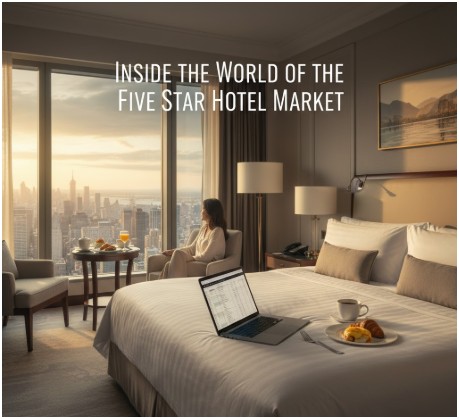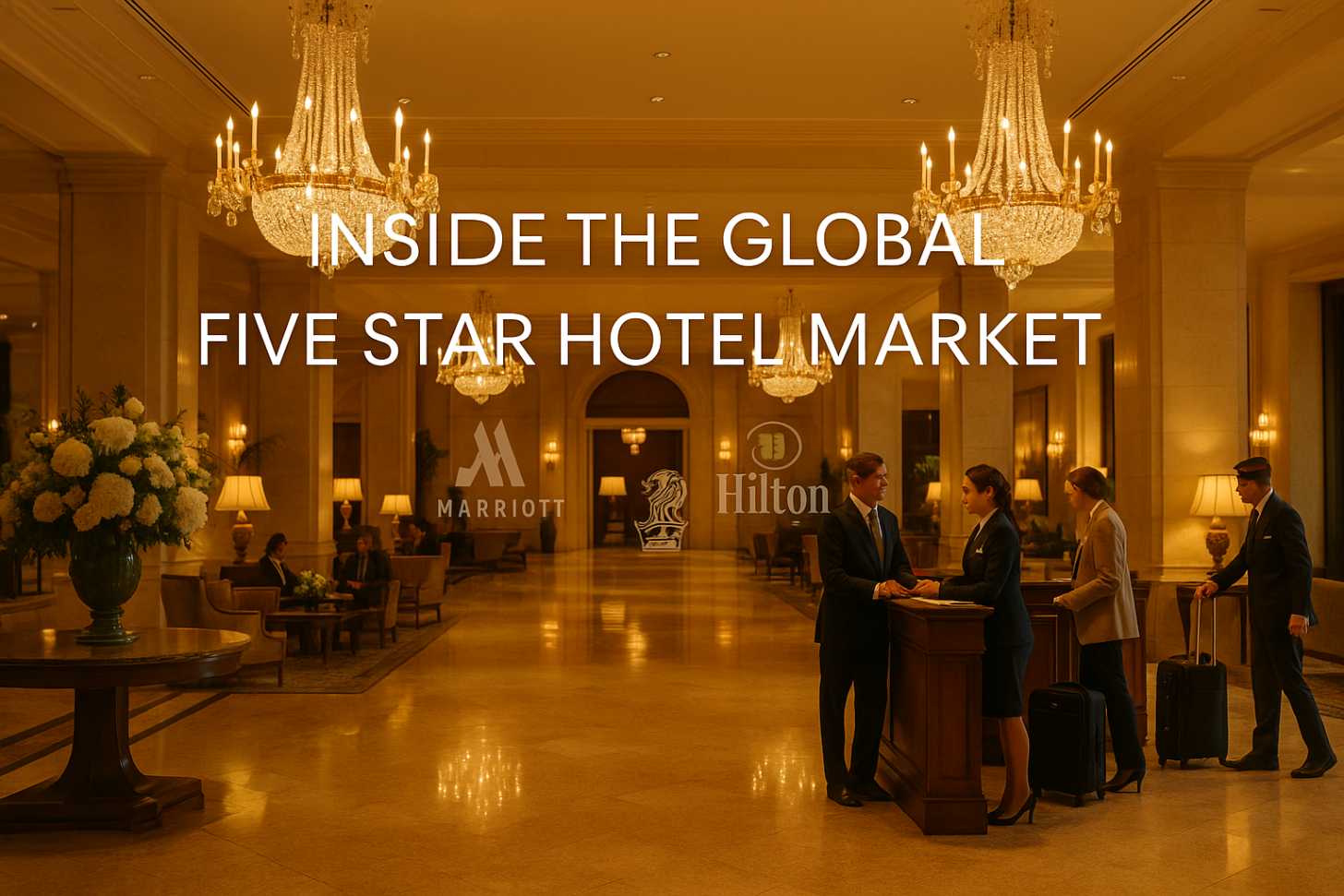A few years ago, I checked into a five-star hotel in Singapore after a grueling 16-hour flight. The moment I sank into that oversized bed and the staff brought up my favorite green tea without asking, I realized something: people aren’t just booking rooms anymore—they’re booking feelings. That’s when I started paying attention to the five star hotel market, and wow, it’s been one wild ride ever since.
Luxury hotels are no longer just about marble floors and champagne breakfasts. They’ve become experiences that blend technology, sustainability, and exclusivity—all wrapped in a bow of personalized service. And judging by the market numbers, it seems everyone wants a piece of that comfort.
How Big Is the Five Star Hotel Market Right Now?

If you thought luxury hospitality was slowing down, think again. The five star hotel market currently stands at a jaw-dropping $154.32 billion in 2024, and projections show it soaring to $369.36 billion by 2032. That’s an impressive 11.5% CAGR—a growth rate most industries would envy.
I see this boom every time I travel. Whether it’s a boutique resort in Bali or a modern skyscraper in Dubai, the luxury scene feels unstoppable. Behind the scenes, that growth comes from global economic expansion, urbanization, and our collective love for tailored experiences.
Let’s face it: when you book a stay, you want more than a room—you want a story. And the big hotel players know that all too well.
Which Brands Are Ruling the Five Star Hotel Market?
When I think luxury hotels, one name always pops up first—Marriott International. It’s not just a giant in the industry; it’s the giant. With powerhouses like The Ritz-Carlton and St. Regis under its belt (plus the integration of Starwood Hotels & Resorts), Marriott has cemented itself as the leader in the five star hotel market.
To put it in perspective, Marriott’s Q3 2025 revenue hit $6.49 billion, and much of that came from its luxury portfolio. That’s not luck—it’s strategy. By combining premium comfort with brand heritage, Marriott keeps customers loyal and investors impressed.
But Hilton isn’t far behind. Its blend of sophistication and innovation makes it a close contender. While Marriott focuses on timeless elegance, Hilton often leans into contemporary style and global accessibility.
Here’s a quick snapshot of how these top contenders stack up:
| Brand | Strength | 2025 Highlights |
| Marriott International | Largest global presence with The Ritz-Carlton and St. Regis | $6.49B Q3 revenue driven by luxury |
| Hilton | Expanding luxury and lifestyle divisions | Rapid portfolio growth in Asia-Pacific |
| Starwood Hotels (Marriott-owned) | Iconic legacy brands like W Hotels and Westin | Strong integration boosts Marriott share |
What’s Fueling the Growth of the Five Star Hotel Market?

Every time I step into a luxury hotel lobby, I can feel the factors driving this surge. And no, it’s not just the scent of lemongrass candles.
First, economic growth plays a massive role. As disposable incomes rise worldwide, more people can afford luxury travel. This democratization of high-end experiences has created a wider customer base.
Second, travel trends have evolved. People now chase unique stays over cookie-cutter vacations. From floating villas in the Maldives to rooftop suites overlooking Manhattan, travelers crave personalization—and five-star brands deliver that perfectly.
Third, technology ties it all together. Smart room controls, mobile concierge apps, and AI-driven personalization enhance guest experiences while streamlining operations. Add to that the convenience of instant online bookings and virtual property tours, and you’ve got a recipe for unstoppable demand.
How Do Hotels Stay Competitive in the Five Star Hotel Market?

Running a five-star property isn’t just about chandeliers and Michelin-starred dining anymore. It’s about keeping pace with a world that never stops moving.
I’ve noticed that hotels that thrive in the five star hotel market often focus on three pillars: innovation, connection, and experience.
- Innovation: The most successful luxury hotels constantly reinvent their spaces and services. Think AI-powered check-ins, eco-friendly architecture, and wellness-focused amenities like sleep pods or infrared saunas.
- Connection: It’s not just about Wi-Fi. Modern travelers value cultural and emotional connection. Luxury chains now weave local art, cuisine, and traditions into their brand experience.
- Experience: The new luxury isn’t loud—it’s thoughtful. Guests don’t just want to stay; they want to feel seen. From remembering your pillow preference to curating a scent for your suite, details make the difference.
How Can You Choose the Right Five Star Hotel for Your Next Trip?
If you’re like me, your definition of “perfect luxury” changes with each destination. Still, a few rules always help me choose wisely in this sprawling five star hotel market.
- Know your vibe. Are you craving peace and privacy or a vibrant city scene? Your mood defines your match.
- Check authenticity. Look for consistency in service quality and verified guest experiences—not just influencer posts.
- Compare perks. Sometimes smaller brands offer more personalized attention than global giants.
I once stayed at a lesser-known eco-luxury resort in Costa Rica that outshone some of the biggest names. The owner greeted guests personally every morning—a reminder that true luxury lies in connection, not just grandeur.
FAQs About the Five Star Hotel Market
Q1: What defines a five-star hotel?
A five-star hotel offers exceptional comfort, superior service, and exclusive amenities. Think spacious rooms, 24-hour concierge, high-end dining, and attention to every detail—from thread count to turn-down chocolates.
Q2: Why is the five star hotel market growing so fast?
Rising incomes, improved global connectivity, and a shift toward experiential travel have fueled demand. People want quality stays that match their lifestyle aspirations.
Q3: Which region dominates the five star hotel market?
Asia-Pacific is leading the expansion, especially in China, India, and Southeast Asia. Rapid urbanization, tourism development, and strong investment in infrastructure make it a hotspot for luxury growth.
Q4: How do technology and sustainability affect the market?
Guests expect both. Hotels now integrate smart room systems, digital check-ins, and sustainable designs—proving that innovation and responsibility can coexist beautifully.
Luxury Never Sleeps—And Neither Does Opportunity
The five star hotel market reminds me of why travel never loses its magic. Behind every lobby chandelier lies an evolving world of innovation, culture, and ambition. The next decade will belong to brands that blend heart with high-tech—those that make guests feel valued, not just served.
So, next time you check into a luxury suite, pause and appreciate the ecosystem that makes that experience possible. Because luxury isn’t just about where you sleep—it’s about how you feel waking up there.









